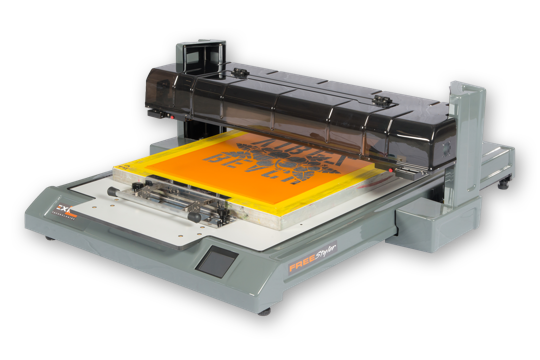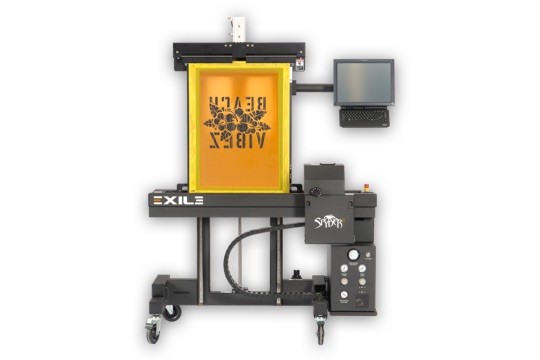Shopping for a Direct-to-Screen System
Here's what to know, what to look for, and what to be wary of when it comes to direct-to-screen (DTS) systems.
Direct-to-screen, also known as computer-to-screen, technology has been around for many years and is now a proven and accepted process for stencil making within the screen-printing industry.
What to know
Direct-to-screen (DTS) or computer-to-screen (CTS) describes the process by which a screen stencil is imaged directly onto a screen. The image is digitally placed on the screen, and screen registration happens automatically. By eliminating film positives and removing many of the labor-intensive tasks involved in the screen-making workflow, substantial cost savings are possible.
For many years the prohibitive cost of DTS machinery held back widespread market acceptance. As prices have fallen and the technology refines, shops have been adopting DTS at a rapid rate. The breakeven point for investment is now as little as 10-20 screens per day for some of the lower-cost DTS systems.
What to look for
Several very different types of DTS systems are available. It is essential to understand what these are before deciding if DTS is right for your business and which kind of DTS system to purchase.
Here is a quick summary of the current technologies available:
Inkjet imaging
Inkjet-based systems print onto standard screen emulsions to replace the film positive with a printed ink stencil. The screen is digitally printed and positioned. The screen is then exposed using UV light, although the exposure process no longer requires a vacuum. There are two main types of inkjet DTS systems:
- Water- or liquid-based inkjet: These use a conventional inkjet process to print a stencil directly onto a standard emulsion-coated screen using water-based black ink with UV-blocking capabilities.

- Wax- or resin-based solid inkjet (phase-change): Wax-based inkjet has a specially modified inkjet system that heats a solid wax ink to turn it into the liquid form before printing. Generally, solid wax ink is known as having superior UV-blocking qualities.

Direct emulsion exposure
Direct emulsion exposure (DLE or DMD) is a process whereby the emulsion is exposed using laser- or LED-focused lights to directly image the screen without the need of a UV-blocking mask or stencil.
These systems produce high-quality images (as much as 2,540dpi), often used in industrial screen-print applications. The advantage of this process is that they use no consumables other than the screen emulsion, although the process does require a fast exposure emulsion, such as a pure photopolymer, to work correctly.
Direct thermal imaging
Direct thermal imaging uses a special silicon-coated screen mesh. The stencil is then imaged using a thermal print head, which melts the silicon coating and opens the mesh to allow the ink to pass through. This process eliminates the need for a darkroom as well as the exposure and washout processes and makes the need for screen reclaim entirely redundant. It is a simple, fast, and clean process.
It does, however, mean that screens are not reusable. Instead, the mesh requires restretching for each print job.
What to be wary of
All of these DTS technologies have their strengths and weaknesses, and these need to be understood before deciding which system to buy.
The main difference between water and solid wax-based ink systems is that water-based ink stencils can be compromised if used with certain types of emulsions. All emulsions naturally absorb water to a greater or lesser degree, and this can reduce the UV-blocking properties of the ink.
With a wax-based inkjet system, the ink reverts to its natural solid-state as soon as it is printed, thereby preventing the emulsion from absorbing any ink. This process results in a very clean dot with minimal dot gain and no overspray. Solid wax ink works with all emulsions as it dries immediately on the surface of the screen.
Inkjet imaging is now extremely fast, with the quickest systems boasting imaging times of under a minute per screen, making them ideal for bigger print shops where 100-200 screens per day can be the norm.
With direct emulsion exposure systems, the main problem is affordability. DLE/DMD systems are considerably more expensive than comparable inkjet DTS technologies. Therefore, they are less likely to appeal to garment screen printers except for those who produce a very high volume of screens where the lack of any consumable (other than the emulsion) justifies the return on investment.
Direct thermal imaging has two main problems: print run lengths and the mesh counts that work with the silicon coating. The coating breaks down much faster than using conventional emulsions, so realistically a maximum print run of 500-1,000 impressions is the practical limit. Also, the silicon coating is only available with medium to high mesh counts, which limits the practical print applications for this process.
Most DTS processes use consumables that are generally much cheaper than the cost of using film positives, and direct exposure systems eliminate the consumable element entirely. Only the direct thermal imaging system is more expensive than using conventional film, but this approach has other savings as screen reclaim is no longer required.
Cost savings aside, the biggest reason to make the change to DTS is improved print quality. No matter how good a film positive, it will never produce the dot quality that can be achieved by a suitable DTS stencil. When using a film positive much of the fine detail is being lost during the exposure process due to under-cutting, which is where the UV light creeps around small highlight dots and exposes the emulsion underneath. With a quality DTS stencil, this is no longer a problem.
DTS offers convenience and streamlines the screen-room workflow. Labor and time savings combined with cheaper consumables can add up to considerable cost savings. Implementing a DTS system is a big decision, but one that has significant cost and quality benefits. What is not in doubt is that DTS has finally arrived in the mainstream and is now worthy of serious consideration.